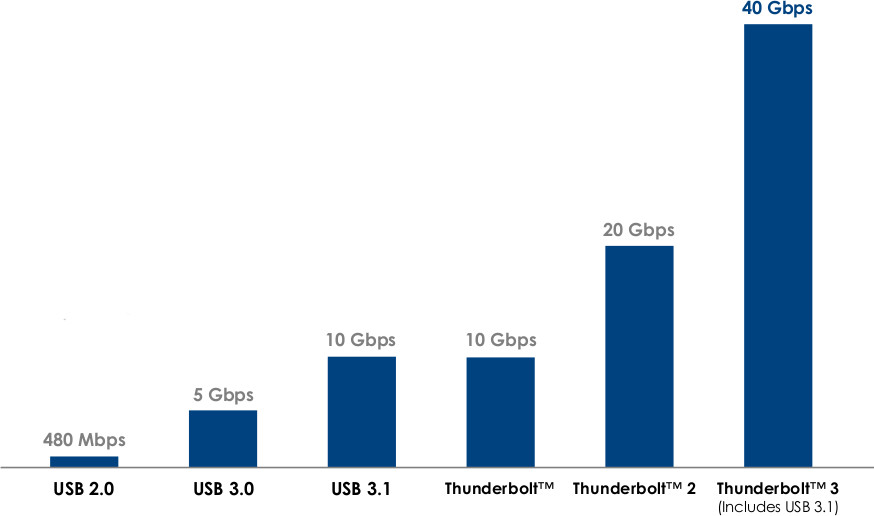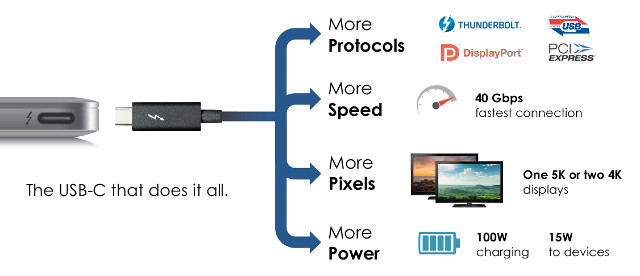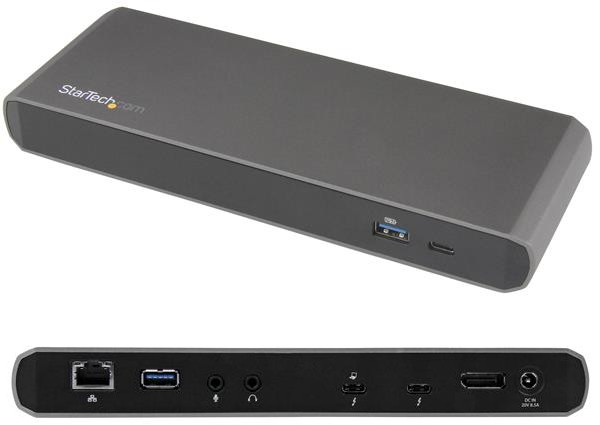Intel Thunderbolt 3 is a single port connect that supports multiple standards (Thunderbolt, USB 3.1, DisplayPort, PCIe), leverages USB-C connector, and offers up to 40 Gbps throughput. So far, it’s mostly found in higher end computers and laptops, but Intel has now announced plans to make it royalty-free, and “release the specifications to the industry” (so maybe not completely free/public) in order to increase adoption of the standard.
- Thunderbolt, USB, DisplayPort, and power on USB-C
- USB-C connector and cables (small, reversible)
- 40 Gbps Thunderbolt 3 – double the speed of Thunderbolt 2
- Bi-directional, dual-protocol (PCI Express and DisplayPort)
- 4 lanes of PCI Express Gen 3
- 8 lanes of DisplayPort 1.2 (HBR2 and MST)
- Supports two 4K displays (4096 x 2160 30bpp @ 60 Hz)
- USB 3.1 (10 Gbps) – compatible with existing USB devices and cables
- DisplayPort 1.2 – compatible with existing DisplayPort displays, devices, and cables
- Connect DVI, HDMI, and VGA displays via adapters
- Power (based on USB power delivery)
- Up to 100W system charging
- 15W to bus-powered devices
- Thunderbolt Networking
- 10Gb Ethernet connection between computers
- Daisy chaining (up to six devices)
- Lowest latency for PCI Express audio recording
 That means eventually we may get devices with a single Thunderbolt/USB-C like smartphones to connect all peripherals including 4K displays, NVMe SSDs, Ethernet, external GPU, etc.., and power/charge the device though a Thunderbolt 3 dock, which can be purchased for $200 and up. One example is StarTech.com Thunderbolt 3 Docking Station with 4K display, Ethernet, Audio and USB ports going for $199.99 on Amazon US.
That means eventually we may get devices with a single Thunderbolt/USB-C like smartphones to connect all peripherals including 4K displays, NVMe SSDs, Ethernet, external GPU, etc.., and power/charge the device though a Thunderbolt 3 dock, which can be purchased for $200 and up. One example is StarTech.com Thunderbolt 3 Docking Station with 4K display, Ethernet, Audio and USB ports going for $199.99 on Amazon US.
Intel also announced plans to integrate Thunderbolt 3 into future Intel CPUs.

Jean-Luc started CNX Software in 2010 as a part-time endeavor, before quitting his job as a software engineering manager, and starting to write daily news, and reviews full time later in 2011.
Support CNX Software! Donate via cryptocurrencies, become a Patron on Patreon, or purchase goods on Amazon or Aliexpress. We also use affiliate links in articles to earn commissions if you make a purchase after clicking on those links.






Hopefully this would end the type c chaos.
This’ll have other benefits, for instance TB3’s 40gbit is hard to reach at the moment due to the PCI-E lanes not being directly fed off the CPU, rather through some intermediary circuitry. Put TB3 on the CPU and with a bit of luck you’ll be able to get full speed and hotplug ability.
@dx
Unlikely, as Thunderbolt cables are more complex, can’t be as long and cost a lot more. It’s not a 1-1 replacement for USB-C.
@TLS
At least vendors have a way of describe what one version of type C to a customer.
I bought a laptop this year with a type C and there’s not indication what it does. 4 months the manufacturer added to their FAQ that it’s USB 3 SS gen1 with 3A@5V power output.
Now vendors have a title to market type C as, in stead of plain “type C”.
This would require that consumers (and reviewers) start to understand/mention that USB-C is not even related to USB3. And this will never happen.
We can only hope that USB-C will be widely adopted and crappy USB-C implementations (used as 5V power input only for example) disappear so the connector itself will not be mentioned any more. Then it will get easy since people start to talk about either USB3 or TB3 and/or the alternate modes (DisplayPort and so on).
@tkaiser
Maybe they should have profiles for USB C to make it clear what is implemented, for example:
USB C basic profile – only 5V power
USB C full profile – Power, Display, Data, etc…
etc…
@cnxsoft
These profiles exist and also logos exist to clearly mark what’s possible: https://en.wikipedia.org/wiki/USB-C#Alternate_Mode_partner_specifications
And then other logos exist that specify the speed (SuperSpeed vs. SuperSpeed Plus) and whether cable and jack are compliant to latest power delivery specs or not (the USB logo then turns into a battery symbol). See picture at the bottom of https://www.heise.de/newsticker/meldung/Viele-neue-Logos-fuer-universelle-USB-Buchsen-2792355.html
Of course there are multiple problems with these logos (starts with the symbols: ‘SS’ for SuperSpeed for example, adding an insanely small ’10’ somewhere when it’s about ‘SuperSpeed Plus’ instead) and market/consumers are used to incorrectly used USB version numbers anyway. Also for vendors it’s more easy to sell stuff as ‘USB 3.1′ (Gen1) so at least some consumers are tricked into believing they would get ’10 GBit’ (while SuperSpeed Plus would be the correct name and USB 3.1 can also be used to describe ‘SuperSpeed’ only which shows just 40% the theoretical bandwidth of ‘SuperSpeed Plus’)
Back on topic: If it’s not about ‘as cheap as possible’ peripherals, hosts and cables (also called ‘USB’) but about Thunderbolt 3 instead everything gets easy since if both Jack and Cable are labeled for Thunderbolt you know automagically that you don’t need to care about this USB-C mess since TB3 is a superset of all the different USB-C modes (including Power delivery specs, DisplayPort and SuperSpeed Plus). Just don’t buy too cheap, watch for the lightning symbol and you’re done.
200usd for a converter?
@zoobab
LOL, calling such a Dock a ‘converter’ is a nice joke (you obviously didn’t look into how signals from one TB3 cable could be converted to/from the various other connectors? 😉 )
BTW: Startech’s Dock is missing charging capabilities for a connected MacBook (Pro) so the Belkin TB3 Dock is most probably a better choice here.
@cnxsoft
BTW: I believe you’re wrong claiming ‘Intel … wants to make [Thunderbolt] royalty-free’ since this would mean they charge current TB adopters today which AFAIK is not true. Intel’s announcement talks about making ‘the Thunderbolt protocol specification available to the industry under a nonexclusive, royalty-free license’. Today such license is not available and you’re tied to Intel for both host and device support (you need any of these TB controller chips on each side of a TB cable + the ‘cable conditioners’ inside the cable plugs), tomorrow we might see TB3 not only in new Intel CPUs but also integrated in other CPUs or SoCs regardless of CPU architecture.
Today one reason for TB equipment still being that expensive is the need to run through an extensive certification process while the market is still a niche even if Apple sold millions of TB equipped hosts within the last 6 years (first TB1 equipped MacBook Pro shipped in early 2011). I hope wider TB3 market adoption brings costs down but also that certification standards aren’t lowered!